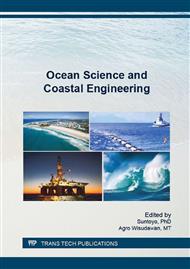p.226
p.232
p.238
p.244
p.253
p.259
p.265
p.271
p.278
Behavior Prediction of Ship Structure due to Side Impact Scenario by Dynamic-Nonlinear Finite Element Analysis
Abstract:
The development of safety has become issue especially for marine and ocean vessels. However, the limitless possibilities of various phenomenon on the sea, make the observation and prediction of ship structure are continuously needed. Side impact is one of those phenomenon. Due to the complexity of ship structure, this phenomenon occurs and produces high nonlinearities, which influence the extent and contour of structural behavior. Such interesting phenomenon was reviewed and studied in present paper using dynamic finite element analysis as the effect of the dependent characteristic of phenomenon to time. Several side scenario models were used to obtain different results in respect of impact location. The kinetic and total energies were presented together with the contours of stress and displacement at two sides of side constructions. Results indicated that the contribution of construction arrangement was significantly affected stress distribution in longitudinal direction of ship hull, while displacement contour from certain scenario produced high intensity on longitudinal member of side construction.
Info:
Periodical:
Pages:
253-258
Citation:
Online since:
January 2017
Authors:
Price:
Сopyright:
© 2017 Trans Tech Publications Ltd. All Rights Reserved
Share:
Citation:


